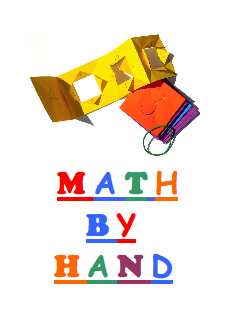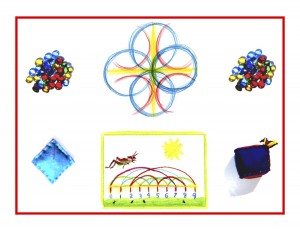
Day 116
For one year, 365 days, this blog will address the Common Core Standards from the perspective of creating an alternate, ambient learning environment for math. Ambient is defined as “existing or present on all sides, an all-encompassing atmosphere.” And ambient music is defined as: “Quiet and relaxing with melodies that repeat many times.Why ambient? A math teaching style that’s whole and all encompassing, with themes that repeat many times through the years, is most likely to be effective and successful.
Today’s post will follow up on the Common Core thread with a link to one of Diane Ravitch’s blogs. This was posted back in January of this year, but is still current and relevant. In it she says, “When I see a child or youth do something joyfully, I can’t help but think . . . that the scores reflect the ability to answer test questions and don’t address the inner core of the human being. Yet our current obsession with data has led us to crush the spirits of our children, to make sure that budding Mozarts and Einsteins and those who dream instead of conforming are pressed into the same narrow mold.”
Entitled “21st Century Child Abuse,” this blog post prompts strong reactions from readers, some questioning whether pedagogical cruelty can be equated with horrific, physical child abuse. These comments spark an intense discussion, with some valid points on both sides. She also includes a New York State parent’s letter lamenting childhood’s losses, taken over by testing and crushing day to day school schedules plus mountains of homework, precluding play and real “home” work, chores and the like, that constitute real life preparation. Ms. Ravitch expresses the hope that Governor Cuomo may read the letter. Here’s the link:
#mce_temp_url#
Knowledge ensues in an environment dedicated to imaginative, creative knowing, where student and teacher alike surrender to the ensuing of that knowledge as a worthy goal. Look for some helpful, Waldorf-oriented posts in the next few days as a farewell to Grade 1.
Tags:
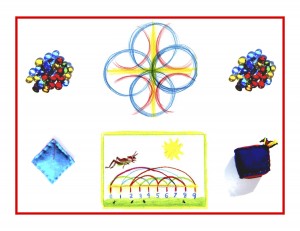
Day 115
For one year, 365 days, this blog will address the Common Core Standards from the perspective of creating an alternate, ambient learning environment for math. Ambient is defined as “existing or present on all sides, an all-encompassing atmosphere.” And ambient music is defined as: “Quiet and relaxing with melodies that repeat many times.Why ambient? A math teaching style that’s whole and all encompassing, with themes that repeat many times through the years, is most likely to be effective and successful.
Well readers I missed posting yesterday, for the first time in 115 posts. I attended a Stop Common Core town hall meeting, and it really did me in. It was encouraging to see such a big turnout. This was the last of a six stop tour here in California, that ended with a rally on the Capitol steps today. The speakers were:
Brad Dacus, President of the Pacific Justice Institute, making opt-out forms and information available to all who need/want them.
Dr. Sandra Stotsky, the only English Language Arts specialist on the Common Core Validation Committee, who refused to sign off on the new standards.
Lydia Gutierrez, a California teacher who asked, “What’s happening in public education; the fallacies of college and career readiness.”
Lots of excellent information and participant energy. So why did it do me in? First off, as an extreme introvert, crowds are not my scene. That aspect was challenging, but beyond that I had gone in with a jaunty optimistic slant: here are parents taking a stand for their families and kids’ teachers! Solid grass roots, right? Well yes but. But I removed the rose colored glasses after seeing the depth and breadth of the Common Core machine. And how very challenging a fight this really is.
Add to that the challenge of being a Waldorf educator and facing the daunting obstacle of speaking for an educational system that, for all the advances it’s made over the years, is still sidelined. As is Rudolf Steiner, its founder. Then there’s this blog. What and why is it, really? When I mentioned my goal with the blog last night: that of taking each Common Core standard and attempting to put it in a child-friendly light, it prompted blank or disbelieving responses. “You’re doing what? Why? Well, good luck with that . . .”
Sooo, one starfish at a time I suppose. See below for this story. And here’s a wonderful statement from Margaret Mead, “Never doubt that a small group of thoughtful, committed citizens can change the world. Indeed, it’s the only thing that ever has.” Knowledge ensues in an environment dedicated to imaginative, creative knowing, where student and teacher alike surrender to the ensuing of that knowledge as a worthy goal.
 An old man walked the beach at dawn. He noticed a boy ahead of him picking up starfish and flinging them into the sea. Finally catching up to the boy, he asked why he was doing this. The answer was that the stranded starfish would die if left until the morning sun. “But the beach goes on for miles and there are millions of starfish,” said the old man. “How can your effort make any difference?” The boy looked at the starfish in his hand and then threw it safely in the water. “It makes a difference to this one,” he said.
An old man walked the beach at dawn. He noticed a boy ahead of him picking up starfish and flinging them into the sea. Finally catching up to the boy, he asked why he was doing this. The answer was that the stranded starfish would die if left until the morning sun. “But the beach goes on for miles and there are millions of starfish,” said the old man. “How can your effort make any difference?” The boy looked at the starfish in his hand and then threw it safely in the water. “It makes a difference to this one,” he said.
Tags:
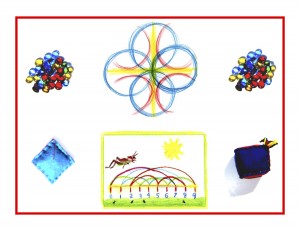
Day 114
For one year, 365 days, this blog will address the Common Core Standards from the perspective of creating an alternate, ambient learning environment for math. Ambient is defined as “existing or present on all sides, an all-encompassing atmosphere.” And ambient music is defined as: “Quiet and relaxing with melodies that repeat many times.”
Why ambient? A math teaching style that’s whole and all encompassing, with themes that repeat many times through the years, is most likely to be effective and successful. Today’s post will review the Geometry standards posted earlier in relation to the form drawing block. The standards will be listed in blue, followed by a summary of the post.
Geometry 1.G
Reason with shapes and their attributes.
1. Distinguish between shapes and their attributes (e.g., triangles are closed and three-sided) versus non-defining attributes (e.g., color, orientation, overall size); build and draw shapes to possess defining attributes.
Day 52: a brief description of the form drawing process, the straight line and curve as the basis of all forms, and the relationship of many geometric forms to the numbers 1-12.
Geometry 1.G
Reason with shapes and their attributes.
2. Compose two-dimensional shapes (rectangles, squares, trapezoids, triangles, half-circles, and quarter-circles) or three dimensional shapes (cubes, right rectangular prisms, right circular cones, and right circular cylinders) to create a composite shape, and compose new shapes from the composite shape.
Day 53: all of these two-dimensional shapes are covered with form drawing, with the circle divided into halves, quarters, eighths, tenths, twelfths, etc. Choosing shapes on worksheets does not do geometry justice, and geometry terms should not be formalized yet. See the Kindergarten post on Day 18, for a hands-on approach to the three dimensional forms. See-through plastic geometry models work well for exploring these shapes. It’s noted that the California State and National Math Standards were more user and child-friendly. Common Core favors a “parts-to-whole” approach that’s abstract and developmentally inappropriate.
Day 54: listing of the California State and National Math Standards and their relationship to / alignment with the Math By Hand form drawing lessons. Question: is the inordinate amount of professional development, lesson prep time, and teaching to the test precluding teachers’ ability to teach meaningfully and effectively?
Geometry 1.G
Reason with shapes and their attributes.
3. Partition circles and rectangles into two and four equal shares, describe the shares using the words halves, fourths, and quarters, and use the phrases half of, fourth of, and quarter of, describe the whole as two of, or four of the shares. Understand for these examples that decomposing into more equal shares creates smaller shares.
Day 55 (in its entirety): The Waldorf method waits until Grade 4 to introduce fractions because the stages of child development determine the time frame of the curriculum. There are solid physiological reasons to wait until age 7 to begin formal teaching, and there are parallel reasons at every stage and age to introduce concepts at the optimal time. Every one of the child’s growth stages marks a significant step away from childhood. The Waldorf method recognizes and heeds these milestones as the drivers of what’s introduced when. For example, creation stories and housebuilding are told and taught in Grade 3 because at age 9, the leave-taking from the garden of childhood is especially intense. Creation stories address this leaving the garden as another step into the world, while supporting accompanying feelings of loss with the tools of living on the earth: gardening, housebuilding, and other useful crafts.
Fractions wait until Grade 4 because they echo the feelings of separation that manifest at that age. Everything in Grade 1 is steeped in the holistic. The circle is broken up into parts, but from a very different angle. The numbers are introduced with a piece of fruit cut up to show how 1 becomes 2, 2 becomes 4, and 4 becomes 8. A form drawing of the circle divided into 8 parts reflects this concept. Wholeness is key now, and though many circles, squares, rectangles, triangles, hexagons, octagons, and more will be partitioned into two and four (and more) equal shares with form drawing, they are not yet equated with fraction terminology.
Faith and trust in the child, the teacher or parent, and the things of the world that can reveal themselves in due course and at the right time is the golden rule. True knowledge ensues in an environment dedicated to imaginative, creative knowing, where student and teacher alike surrender to the ensuing of that knowledge as a worthy goal. All that the Common Core asks (and so much more) is covered by the excellence that is form drawing.
Tags:
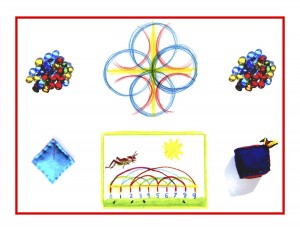
Day 113
For one year, 365 days, this blog will address the Common Core Standards from the perspective of creating an alternate, ambient learning environment for math. Ambient is defined as “existing or present on all sides, an all-encompassing atmosphere.” And ambient music is defined as: “Quiet and relaxing with melodies that repeat many times.”
Why ambient? A math teaching style that’s whole and all encompassing, with themes that repeat many times through the years, is most likely to be effective and successful. Today’s standard will be listed in blue, followed by its ambient counterpart.
Measurement and Data 1.MD
Represent and interpret data.
4. Organize, represent, and interpret data with up to three categories; ask and answer questions about the total number of data points, how many in each category, and how many more or less are in one category than another.
This needs to be very informal. Excel spreadsheets, or formal charts and graphs for that matter, should not be the venue here. More like, three or four small shoeboxes perhaps painted or covered with kraft paper to hold collections, will suit the purpose nicely. Children are natural collectors, and do not need much encouragement to organize and categorize their treasures. Nature walks are the perfect occasion to gather various specimens like acorns, pine cones, stones, shells, and many more wonders. All children relish the opportunity to look closely at the minutiae of their surroundings in the natural world.
This collection could be accompanied by a small, colorful record keeping notebook. Sections could be created for each category, with the data updated as more specimens or additional categories are added. A color-coding system may be useful, using a different colored pencil for each category. Matching colored index tabs could be added for easy perusing. All junior scientists are more than happy to talk about their collections, and could be guided to be consistent in their documentation. One large page (kept separately and inserted into the notebook) could list all of the categories side by side, color coded and updated as needed.
As always, it’s movement, story, and art that win the math day! Knowledge ensues in an environment dedicated to imaginative, creative knowing, where student and teacher alike surrender to the ensuing of that knowledge as a worthy goal.
Tags:
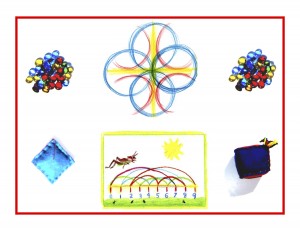
Day 112
For one year, 365 days, this blog will address the Common Core Standards from the perspective of creating an alternate, ambient learning environment for math. Ambient is defined as “existing or present on all sides, an all-encompassing atmosphere.” And ambient music is defined as: “Quiet and relaxing with melodies that repeat many times.”
Why ambient? A math teaching style that’s whole and all encompassing, with themes that repeat many times through the years, is most likely to be effective and successful. Today’s standard will be listed in blue, followed by its ambient counterpart.
Measurement and Data 1.MD
Tell and write time.
3. Tell and write time in hours and half-hours using analog and digital clocks.
This is too abstract and advanced for first grade. For reasons cited in earlier posts, the optimal time to teach time is third grade. A more generalized sense of time can begin early on, but it’s a sense that must be allowed to grow gradually, not be taught abstractly with apps or worksheets. Here is an excellent article on the subject from Mum’s School Zone:
#mce_temp_url#
Fairy tales are a nurturing way to introduce the concept of time. The Twelve Months is a Russian fairy tale that casts the months as a circle of twelve men ranging in age from very young to very old. The ages of the men are related to the seasons, starting with Spring as the youngest and ending with Winter as the oldest.
This fairy tale is told in relation to the number 12 in the Math By Hand curriculum, retold by the children the next day, and illustrated with a form drawing: the circle divided into 12 with 3 segments representing each season. This is a link to Knit and Knag Designs, a website that offers knitting patterns seemingly related to folk and fairy tales. Here the story is called Marushka Fairy Tale in honor of the young girl who goes out into the world with nothing and is rewarded for her goodness and kindness.
#mce_temp_url#
As always, it’s movement, story, and art that win the math day! Knowledge ensues in an environment dedicated to imaginative, creative knowing, where student and teacher alike surrender to the ensuing of that knowledge as a worthy goal.
Tags:

Day 111
For one year, 365 days, this blog will address the Common Core Standards from the perspective of creating an alternate, ambient learning environment for math. Ambient is defined as “existing or present on all sides, an all-encompassing atmosphere.” And ambient music is defined as: “Quiet and relaxing with melodies that repeat many times.”
Why ambient? A math teaching style that’s whole and all encompassing, with themes that repeat many times through the years, is most likely to be effective and successful. Today’s standard will be listed in blue, followed by its ambient counterpart.
Measurement and Data 1.MD
Measure lengths indirectly and by iterating length units.
2. Express the length of an object as a whole number of length units, by laying multiple copies of a shorter object (the length unit) end to end; understand that the length measurement of an object is the number of same-size length units that span it with no gaps or overlaps. Limit to contexts where the object being measured is spanned by a whole number of length units with no gaps or overlaps.
Perhaps the most important element here is that the lesson or activity is themed. All too often lessons are presented on their own and out of context. This is in fact a predominant feature of an abstract rather than concrete approach, and as such is self-defeating. The child wants to know the world and the things in it, and this manifests as a deep need for connection. That’s why everything presented or taught must be in context and proceed from the whole to parts. Alienation from others, nature, and the self may be the predominant disease of our times, for which the cure is connection and a holistic approach.
Nature walks are a perfect venue for this sort of measuring. Gather some acorns, then find a downed oak branch. Line the acorns up on the branch (upside down on their caps may be easier), touching with no gaps. This requires some delicate balancing and is an opportunity to hone fine motor skills. After covering the length of the branch, count the acorns. Say, “This branch is __ acorns long. It is just a small part of a mighty oak tree (point one out) that was once so small it slept all curled up inside an acorn.”
One of my daughter’s first grade knitting projects was a small sitting cat, made from a simple knitted square. Knitting fosters right-left brain balance, develops focus and dexterity, and not least, builds self esteem through creating something both useful and beautiful. Knitting can also be an excellent application of this measurement standard: counting the stitches in a row or counting the number of rows needed to make the finished square.
Here’s how to make the cat:
knit a 6 inch square
fold it in half and whip-stitch the top and side, leaving the bottom open
take a small stitch on both sides of the very top to form 2 triangles (the ears)
stuff the cat with wool or cotton batting leaving the bottom open so the cat sits upright
finger knit a collar, about 10 inches long, and tie it in a bow around the cat’s neck MEOW ; )
As always, it’s the movement, story, and art that win the math day! Knowledge ensues in an environment dedicated to imaginative, creative knowing, where student and teacher alike surrender to the ensuing of that knowledge as a worthy goal.
Tags:
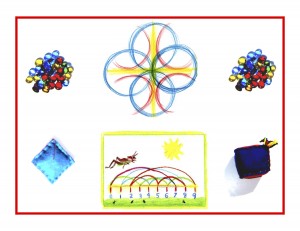
Day 110
For one year, 365 days, this blog will address the Common Core Standards from the perspective of creating an alternate, ambient learning environment for math. Ambient is defined as “existing or present on all sides, an all-encompassing atmosphere.” And ambient music is defined as: “Quiet and relaxing with melodies that repeat many times.” Why ambient? A math teaching style that’s whole and all encompassing, with themes that repeat many times through the years, is most likely to be effective and successful.
Time for a blog break. Please do watch this wonderful portrait of Waldorf, filmed at the Marin Waldorf School. And know that you can embody the Waldorf way at home as well. Love is key: love of and deep respect for both the child and the things of the world that are brought before the child. Anyone who is open to a child-centered approach can teach this way, enabling a joyful learning that continues lifelong as the end result! Knowledge ensues in an environment dedicated to imaginative, creative knowing, where student and teacher alike surrender to the ensuing of that knowledge as a worthy goal.
#mce_temp_url#
Tags:
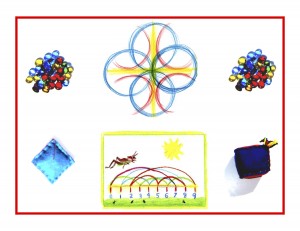
Day 109
For one year, 365 days, this blog will address the Common Core Standards from the perspective of creating an alternate, ambient learning environment for math. Ambient is defined as “existing or present on all sides, an all-encompassing atmosphere.” And ambient music is defined as: “Quiet and relaxing with melodies that repeat many times.”
Why ambient? A math teaching style that’s whole and all encompassing, with themes that repeat many times through the years, is most likely to be effective and successful. Today’s standard will be listed in blue, followed by its ambient counterpart.
Measurement and Data 1.MD
Measure lengths indirectly and by iterating length units.
1. Order three objects by length; compare the lengths of two objects indirectly by using a third object.
Though measurement and time are not taught directly in the Waldorf school until Grade 3, foundational activities and lessons can pave the way for more formal learning. Here is an excerpt from Day 27 re the Common Core Kindergarten measurement standards:
As with many other elements, exposure to time and measurement will most likely happen way before third grade, but its formal introduction doesn’t happen till then. The reasoning is that the child crosses a significant boundary at age 9. Just as a readiness for learning becomes optimal at age 7, the first real steps out of the garden of childhood are taken two years later, at 9. Creation stories are told in third grade, as the child’s powers of reasoning develop alongside a beginning recognition of the realities of growing up.
As a thread that runs through most cultures’ creation stories, the expulsion from the garden is a theme that reflects this stage of development. Teaching practical things like housebuilding and farming / gardening are perfect at this time, because that’s how we collectively learned to live on the earth on our own, after leaving our respective gardens. Time and measurement fit this context nicely and for now, aspects of it can be shown and absorbed (rather than taught and learned) in a purely experiential and playful way.
I’m noticing after having gone back to the Kindergarten posts to find this, that the Kindy Common Core standards seem to be more creative and fun. It’s more challenging to come up with something for this standard. Let’s see. The most likely venues for practicing this would be the morning circle, nature studies, handwork, and form drawing. Taking these one by one,
Morning Circle:
Some wonderful movement exercises can be done with rods or dowels. To enhance a sense of the vertical and horizontal, the rod could be passed back and forth (rhythmically in time to a song or verse), first vertically then horizontally. Different length rods could be used for this exercise to address this standard, by exchanging them in succession while having the child measure each one against his or her own body. A special verse could be recited or sung along with this, something like:
This rod is wood, it came from a tree,
It’s little, it only reaches up to my knee.
This rod is smooth, it slides and slips,
It’s bigger, it reaches up to my hips.
And so on . . .
Nature Studies:
There are many opportunities for informal measurement on a walk in the woods or reviewing the treasures brought back from one. Specifically, a pine cone might be used to measure a foot print with, “How many pine cones long is your foot? How many is mine?” Or leaves and flower petals could be measured, “How many rose petals long is a maple leaf?”
Handwork:
Knitting needles could be measured with each other as they are cut, pointed, and sanded in preparation for a first knitting lesson. Cutting, measuring, and piecing patterns for simple sewing projects is another excellent opportunity to practice this standard.
Form Drawing:
Almost all straight-line form drawings offer opportunities to compare lengths. As an added element to the usual prep for form drawing (moving the form large by walking or running it) models could be used as well. Graduated-size straight sticks could be put together in their proper order before either moving or drawing the form. See below for a graduated lines form drawing.
As always, it’s the movement, story, and art that win the day with math! Knowledge ensues in an environment dedicated to imaginative, creative knowing, where student and teacher alike surrender to the ensuing of that knowledge as a worthy goal.

Tags:
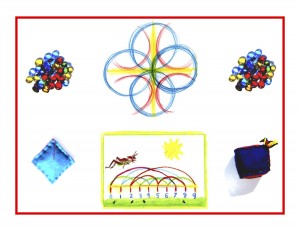
Day 108
For one year, 365 days, this blog will address the Common Core Standards from the perspective of creating an alternate, ambient learning environment for math. Ambient is defined as “existing or present on all sides, an all-encompassing atmosphere.” And ambient music is defined as: “Quiet and relaxing with melodies that repeat many times.”
Why ambient? A math teaching style that’s whole and all encompassing, with themes that repeat many times through the years, is most likely to be effective and successful. Today’s standard will be listed in blue, followed by its ambient counterpart.
Number and Operations in Base Ten 1.NBT
Use place value understanding and properties of operations to add and subtract.
6. Subtract multiples of 10 in the range 10-90 from multiples of 10 in the range 10-90 (positive or zero differences), using concrete models or drawings and strategies based on place value, properties of operations, and/or the relationship between addition and subtraction; relate the strategy to a written method and explain the reasoning used.
Today’s standard is similar to yesterday’s, and it seems both are meant as preparation for working with the tens place in place value. The “concrete models or drawings” portion has resulted in students having to draw “hash marks and polka dots” to represent numbers and groups of numbers. This is cumbersome at best and deadening at worst. Math begs to be enlivened and made part of life. This is what engages students and enables math success.
Generally speaking, I find the Common Core language to be convoluted and unnecessarily obscure and difficult. The California State Math Standards by comparison, are clear and straightforward. I have retained these and the National Math Standards as references for the Math By Hand curriculum. Here are the California standards that are comparable to the Common Core Operations and Algebraic Thinking and Number and Operations in Base Ten.
Number Sense
1.0) Students understand and use numbers up to 100.
1.1) Count, read, and write whole numbers to 100.
1.2) Compare and order whole numbers to 100 by using the symbols for less than, equal to, or greater than (<, =, >).
1.3) Represent equivalent forms of the same number through the use of physical models, diagrams, and number expressions (to 20) (e.g., 8 may be represented as 4+4, 5+3, 2+2+2+2, 10-2, 11-3).
1.4) Count and group objects in ones and tens (e.g., 3 groups of 10 and 4 = 34, or 30+4).
1.5) Identify and know the value of coins and show different combinations of coins that equal the same value.
2.0) Students demonstrate the meaning of addition and subtraction and use these operations to solve problems.
2.1) Know the addition facts (sums to 20) and the corresponding subtraction facts and commit them to memory.
2.2) Use the inverse relationship between addition/subtraction to solve problems.
2.3) Identify 1 more than, 1 less than, 10 more than, 10 less than a given number.
2.4) Count by 2s, 5s, and 10s to 100.
2.5) Show the meaning of addition (putting together, increasing) and subtraction (taking away, comparing, finding the difference).
2.6) Solve addition and subtraction problems with one- and two-digit numbers.
2.7) Find the sum of 3 one-digit numbers.
3.0) Students use estimation strategies in computation and problem solving that involve numbers that use the ones, tens, and hundreds places.
3.1) Make reasonable estimates when comparing larger or smaller numbers.
Algebra and Functions
1.0) Students use number sentences with operational symbols and expressions to solve problems.
1.1) Write and solve number sentences from problem situations that express relationships involving addition and subtraction.
1.2) Understand the meaning of the symbols +,-,=.
1.3) Create problem situations that might lead to given number sentences involving addition and subtraction.
Aren’t these standards clearer and more straightforward? “If it ain’t broke, don’t fix it.” comes to mind here. There does seem to be a grass roots movement afoot to repeal/replace the Common Core with more workable standards. And this may very well happen in more states than not, in light of the fact that the Common Core may have been hastily conceived then rolled out without proper vetting and viability. The fact remains that math is a much-beleagered subject and sorely in need of a lively and sensible teaching approach. Waldorf and Math By Hand methods may be just the ticket!
As always, it’s the movement, story, and art that win the day with math! Knowledge ensues in an environment dedicated to imaginative, creative knowing, where student and teacher alike surrender to the ensuing of that knowledge as a worthy goal.
Tags:
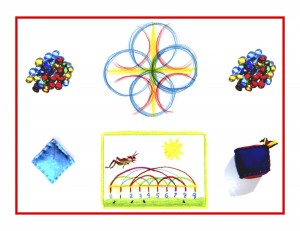
Day 107
For one year, 365 days, this blog will address the Common Core Standards from the perspective of creating an alternate, ambient learning environment for math. Ambient is defined as “existing or present on all sides, an all-encompassing atmosphere.” And ambient music is defined as: “Quiet and relaxing with melodies that repeat many times.”
Why ambient? A math teaching style that’s whole and all encompassing, with themes that repeat many times through the years, is most likely to be effective and successful. Today’s standard will be listed in blue, followed by its ambient counterpart.
Number and Operations in Base Ten 1.NBT
Use place value understanding and properties of operations to add and subtract.
5. Given a two-digit number, mentally find ten more or ten less than the number, without having to count; explain the reasoning used.
Having explored the -teens and -ty’s through stories, pictures, and hands-on activities, it’s now possible to find the next ten, up or down, of any number. The -ty’s lesson showed that the multiples of ten are basically the same as counting in ones. It was seen that some of the ‘ty’s change their names and some don’t. For example, two becomes twenty, three becomes thirty, four becomes forty, five becomes fifty, but six stays sixty, seven: seventy, eight: eighty, and nine: ninety.
Armed with this inside information the first grader can confidently proceed, knowing that it’s all just counting, using the same numbers! So then it’s just simple mental calculation to go up and down the tens ladder. Take ten away from seventy two = sixty two. Being able to count from 1-10 forward and backward makes all of this possible. Here’s a foundational place value activity/lesson.
Gather twenty or so palm-sized flat, smooth stones. (We’re living in rock heaven here, with four major rivers nearby.) If none are readily available outdoors, your local garden supply should have a nice selection of stones for sale. Have your child write the numbers 0 – 9, one number per stone, two stones for each number. Line up the number stones 1-9 in a vertical column, then take the other stones, randomly one at a time, and place each one next to the numbers in the first column, having the child say each number while doing this. For example, with the 3 stone it would be thirteen, twenty three, thirty three, etc. Physically moving the numbers up and down are a good hands-on means of exploring ten more and ten less.
This could inspire morning circle activities as well: 1) Toss a ball or bean bag while saying, “sixty six, ten less” and have the child toss it back with the answer, “fifty six.” 2) Have the child toss a ball or bean bag from hand to hand / toss it up and catch it / pass it from front to back and back to front while saying several tens in a row, “forty three, fifty three, sixty three.” 3) Marching in a circle with your child, say a number as the second digit and have the child say the -ty’s with it while marching: you say, seven s/he says, seventeen, twenty seven, thirty seven . . . and so on, up to ninety seven. Add some lively fun to this last one with a tambourine, rhythm sticks, a small drum, etc. “Explaining the reasoning used” can wait until there’s the capacity for abstract thinking at 11 or 12.
As always, it’s the movement, story, and art that win the day with math! Knowledge ensues in an environment dedicated to imaginative, creative knowing, where student and teacher alike surrender to the ensuing of that knowledge as a worthy goal. More Common Core Grade 1 Number and Operations in Base Ten Standards with their ambient counterparts tomorrow!
Tags:

